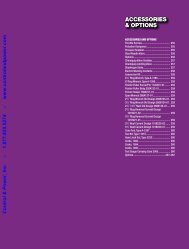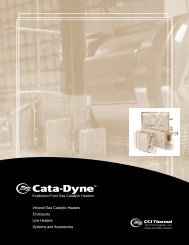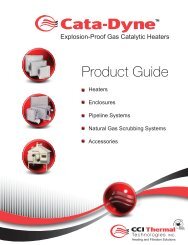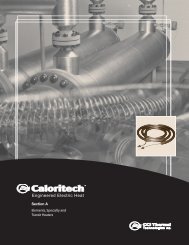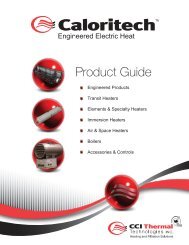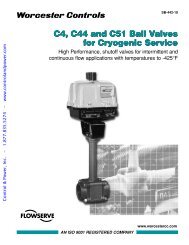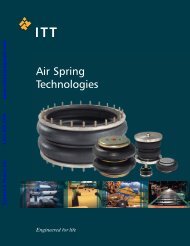Gestra Products Technical - Control And Power
Gestra Products Technical - Control And Power
Gestra Products Technical - Control And Power
You also want an ePaper? Increase the reach of your titles
YUMPU automatically turns print PDFs into web optimized ePapers that Google loves.
Level <strong>Control</strong>, Monitoring and Limitation<br />
Principles of Measurement<br />
Conductivity measurement<br />
The water level is detected between the<br />
electrode tips and the vessel wall (or reference<br />
electrode) and evaluated for control or limitation<br />
purposes. In this case it is essential that<br />
the medium is electrically conductive.<br />
The high-integrity self-monitoring design of<br />
the level alarms ensures constant supervision<br />
of the insulating seal and electrode entry,<br />
immediately recognizing malfunctions in the<br />
system and failure of the electrode or supply<br />
cables. In addition, the equipment features<br />
periodic self-checking of the electronic control<br />
unit and the corresponding output contacts.<br />
Self-monitoring equipment with periodic selfchecking<br />
is required for boilers with temperature/pressure<br />
ratings > 1 bar and > 120 °C<br />
and a volume > 50 l.<br />
Before installation, the length of the conductivity<br />
electrode rods must be cut to the<br />
required switching levels.<br />
Capacitance measurement<br />
Electrode rod and vessel wall (or reference<br />
electrode) form a capacitor; air and the fluid<br />
to be controlled act as dielectric. Due to<br />
the different dielectric constants of air and<br />
boiler water the capacitance value between<br />
the electrode and the vessel wall changes<br />
concurrently with level changes.<br />
The switchpoints can be continuously adjusted<br />
during operation and multiplied by connecting<br />
in parallel several electronic control units.<br />
Types of <strong>Control</strong>s<br />
Water level limiters<br />
(High-level/low-level alarms)<br />
As soon as the water level exceeds or falls<br />
below the adjusted switchpoints the burner<br />
protection circuit is interrupted (low level) or<br />
the feed pump is switched off (high level).<br />
On-off level control<br />
The water level is controlled between two fixed<br />
or adjustable switchpoints. The signals are<br />
directly transmitted to the feed pump or valve.<br />
Modulating level control<br />
The water level is continuously monitored and<br />
the actual value is compared with the adjusted<br />
set point by the associated controller. If a<br />
deviation between the two values is detected,<br />
a signal will be sent to the control valve to<br />
re-adjust the flowrate accordingly, thereby<br />
enabling a more economic and efficient steam<br />
plant operation.<br />
Field Bus System<br />
Digital Data Exchange<br />
The Spector Bus system transfers the digitized<br />
measurement data acquired by the level<br />
probe to the electronic control unit located in<br />
the control cabinet. The centerpiece of this<br />
system is the stable and sophisticated CAN<br />
bus (<strong>Control</strong>ler Area Network). Several sensors<br />
and switches can be interconnected via one<br />
bus line.<br />
Apart from active cable monitoring a CAN<br />
bus system offers a host of benefits, such as<br />
increased design flexibility, reduced installation<br />
effort, optimized open and closed loop control,<br />
centralized operation and remote monitoring.<br />
The standardised network opens up highly<br />
flexible possibilities for configuration. The<br />
CANopen protocol is used nowadays in medical<br />
equipment, electronic devices for marine<br />
applications, public means of transport and in<br />
burner and boiler controls of power plants.<br />
Thanks to the many CANbus applications a<br />
great number of equipment and interface<br />
components are widely available, providing an<br />
ideal addition to our product range.<br />
MIN<br />
URB 1<br />
READY<br />
TO<br />
OPERATE<br />
P E<br />
M<br />
1<br />
2<br />
Max NRS 2 -40<br />
1 2<br />
3<br />
Min<br />
P<br />
3 4<br />
E<br />
4<br />
Test<br />
77<br />
B



